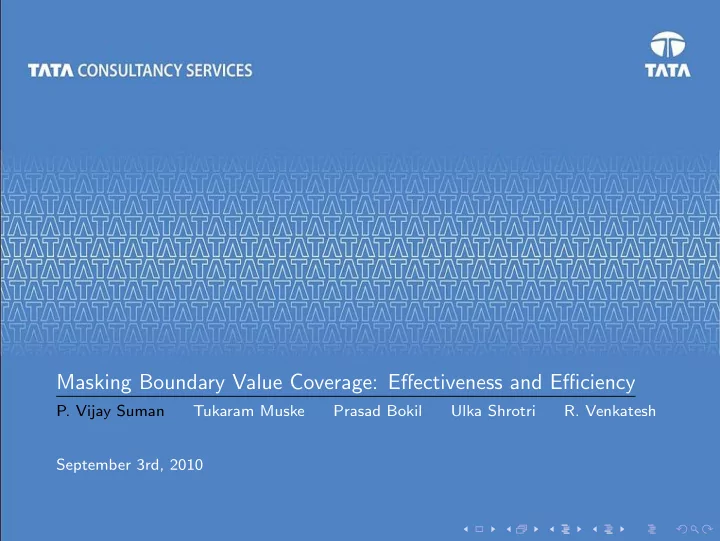

Masking Boundary Value Coverage: Effectiveness and Efficiency P. Vijay Suman Tukaram Muske Prasad Bokil Ulka Shrotri R. Venkatesh September 3rd, 2010
Context/Ad (Work at TRDDC, Pune) ◮ Our Group: Verification and Validation of Embedded Systems ◮ Statechart Analysis, Program Analysis, Testing etc. ◮ Testing: Develop testing tools towards meeting international standards and customer requirements ◮ Boundary value coverage arised from one of our automotive domain customer requirement
Overview ◮ Present two white-box coverage criteria for relational testing. . . 1. Boundary Value Coverage (BVC) 2. Masking Boundary Value Coverage (MBVC) Both target relational bugs ◮ Argue that MBVC test data is (better) relatively more effective than BVC test data ◮ Experimental data supporting our claim/argument ◮ Conclusions
Relational Testing Masking of Conditions MBVC Vs. BVC Conclusion
Boundary Values Given Code Intended Code int inp, op; int inp, op; void func() void func() { { if(inp > 10) if(inp > 9) op = 1; op = 1; else else op = 0; op = 0; } } Boundary Value Test Data inp Actual O/P Expected O/P 9 0 0 10 0 1 11 1 1
Errors Intended to be Detected We consider detecting (exactly one at a time*). . . 1. Off-by-one errors 2. Incorrect operator errors Let (a > 10) be the given relational condition Intended Code Necessary Boundary Value a>9 10 a>11 11 10 a>=10 9,11 a<10 9,10,11 a<=10 a==10 10 a!=10 9 * Combination of these errors: More test data required
Relational Testing Masking of Conditions MBVC Vs. BVC Conclusion
Masking - Independent Effect Function Variant int inp1, inp2, op; int inp1, inp2, op; void func() void func() { { if(inp1 && inp2) if(inp1 || inp2) op = 1; op = 1; else else op = 0; op = 0; } } Condition Coverage Vs. Masking MC/DC: inp1 inp2 Function O/P Variant O/P Function O/P Variant O/P inp1 inp2 1 1 1 1 0 0 0 0 1 0 0 1 1 1 1 1 0 1 0 1
Masking BVC Function Variant int inp1, inp2, op; int inp1, inp2, op; void func() void func() { { if((inp1 > 10) && inp2) if((inp1 > 9) && inp2) op = 1; op = 1; else else op = 0; op = 0; } } Function O/P Variant O/P Function O/P Variant O/P inp1 inp2 inp1 inp2 9 0 0 0 9 1 0 0 10 0 0 0 10 1 0 1 11 0 0 0 11 1 1 1
Relational Testing Masking of Conditions MBVC Vs. BVC Conclusion
Mutation ◮ We compare MBVC and BVC using mutation ◮ Mutation is purposely modifying code to simulate an error ◮ Example: Replace > by one of > =, < , < =, == and ! = ◮ Mutation Adequacy of a test suite: Fraction of the given set of mutants it detects ◮ “Criterion C 1 better than C 2 ” � Mutation adequacy of test suite for C 1 is greater than that of test suite for C 2 ◮ We implemented a mutation analysis tool, which introduces ◮ Off-by-one errors ◮ Incorrect operator errors
Experimental Setup ◮ Application: An automobile battery controller code ◮ Randomly 12 modules out of 22 were selected ◮ For each function f do. . . 1. Generate MBVC and BVC test data for f (our white-box tool AutoGen) 2. f –(mutate at unit level)– > M 3. Run both on M and compute adequacies
MBVC Vs. BVC: Effectiveness Funcs with Combinations of Rel Ops 74 3646 LOC MBVC is better 42 56 % BVC is better 0 0 % Both equally good 32 44 % Total Mutants Generated 4627 Mutants killed by MBVC 3734 80.7% Mutants killed by BVC 3253 70.3% Detectable Mutants (Extrapolated) 4026 (Slide 15) Mutants killed by MBVC test data 3734 92.75% Mutants killed by BVC test data 3253 80.8%
MBVC Vs. BVC: Efficiency Parameter of Generation Hike for MBVC Time* 9.38% Size** 28.65% *The constraint that is generated by the model checker will be stronger when masking is used. **The probability of a test vector covering multiple states goes down in presence of masking.
Propagation Problem Limitation of Masking: Following kind of mutants might not be detected int inp1, inp2, op; void func() { int local; if( inp1 > 10 && inp2) //if( inp1 > 11 && inp2) local = 1; else local = 0; if( local || inp3 ) op = 1; else op = 0; } Two MBVC/BVC Test Data Entries for Decision 1 inp1 inp2 inp3 Actual O/P Expected O/P 11 1 1 1 1 11 1 0 1 0
Relational Testing Masking of Conditions MBVC Vs. BVC Conclusion
Contributions 1. Analysis of boundary value analysis applied in the white-box setting (BVC) 2. Analysed the effect of extending BVC with masking of conditions 3. Gave formal argument and experimental evidence, both mutation based, that MBVC test data is better than BVC 4. Usage of a restricted mutation operator to compare criteria aiming specific kind of bugs
Limitations 1. We consider only those functions for which the model checker terminated. A more fair analysis would require significant efforts towards loop abstraction 2. Sizes of the test sets being compared are not same. By padding more test data to the BVC test set we could have made it as big as that for MBVC
Thank you Questions . . .
Recommend
More recommend